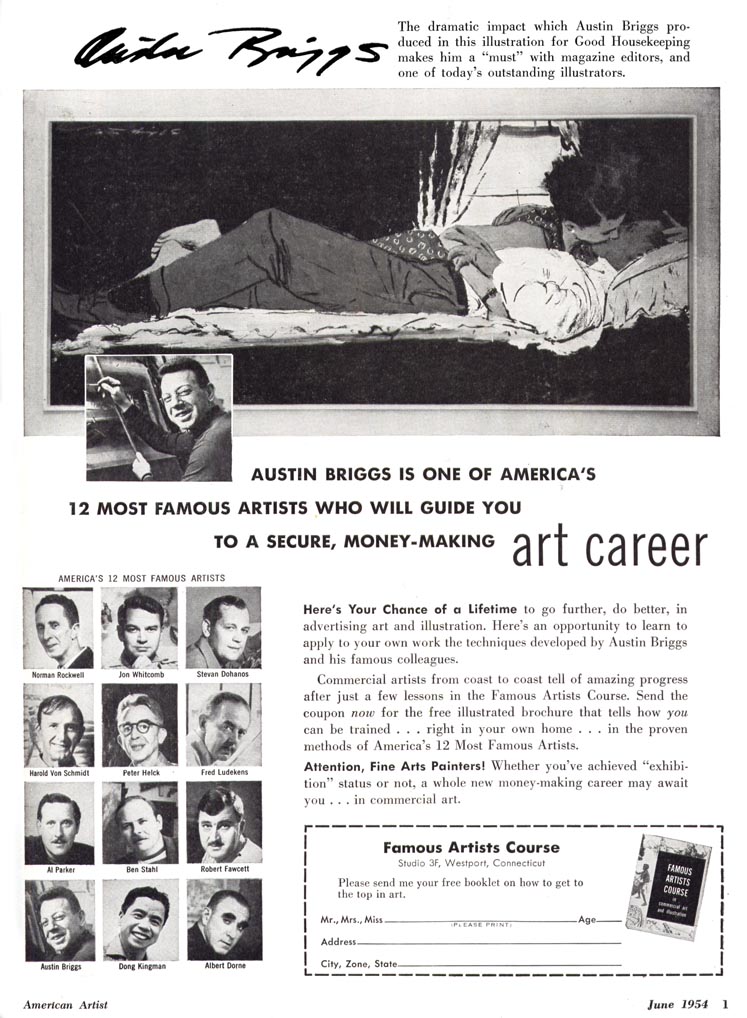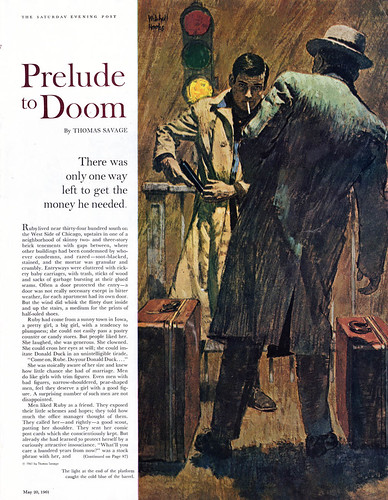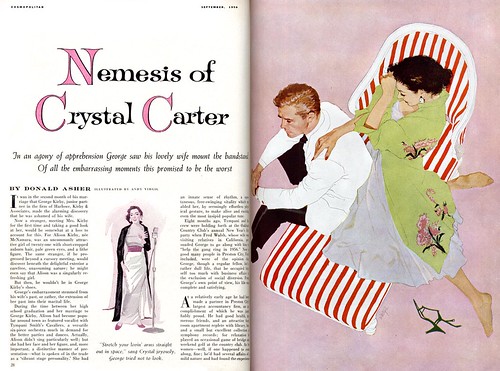
Certainly illustrators of the calibre of Austin Briggs would have agreed with Rodewald. If he was paid much less than he would have been by advertising clients, it never deterred him from taking magazine assignments. For the illustrator and the magazine, there was always a mutually beneficial arrangement. Both enjoyed greater cachet with the public when they were in each other's company.

And in fact, at least some artists were able to make an astoundingly lavish income from magazine work. Just last night, illustrator Murray Tinkelman, who teaches an MFA Illustration program at Hartford University, graciously sent along an excerpt from the minutes of a 1936 Society of Illustrators meeting. Just look at some of the following figures and consider these numbers in modern dollars:
"From $2,000,000 to $3,000,000 a year is being paid to illustrators by these ten mags:
SEP, Collier's, Liberty, Cosmo, American Mag, Good House, Ladies HJ, McCalls, Womans HC."
"From 20 to 25 men and women are making between $50,000 and $100,000 a year. From 50 to 75 men are making between $25,000 and $40,000. 100 are making $15,000 to $20,000"
Harrison Fisher, $3,000 per cover Cosmo.
McMein, $2,500 per cover McCalls.
Rockwell, $2,500 per cover.
"10 men get $1,200 to $2,000 per single illus."

Of course these astonishing figures are a reflection of a time when magazines ruled the media with weekly circulations in the millions and hundreds of national advertisers taking full and double page spreads in every issue. By the late 50's and early 60's, with the erosion of ad revenue brought on by television's rise, prices seem to have begun their decline.
Murray tells me he received $1,000 for a full page illustration in The Post in 1963, and Mitchell Hooks spoke about getting only around $300 a page when his work began appearing there in the late 50's. Prices, it seems, were not standardized and were tied to some extent to the stature of the illustrator (a Coby Whitmore or a Joe De Mers would command top dollar) and the art director's perception of the 'value' of the artwork (Murray explains that paintings done by the 'clinch' artists paid better than humorous/decorative stylized artwork of the sort he was doing).
But whether the work was in the hundreds of dollars or several thousand, a dollar back then went a lot farther than it does today.

When Anita Virgil wrote about her late husband Andy receiving a 12 month commission from McCall's in 1959, she said he was contracted at a rate of $1,250 - $2,000 per illustration. That contract gave the young couple the confidence to purchase a house in the New Jersey countryside and begin a family.
While a commission of that sort would be nice even today, would anyone actually see it as a catalyst for securing a mortgage?

I can only use coffee shop wisdom to guess at how much the value of a dollar has shifted in half a century, but look at it this way: in the 1950's a candy bar was ten cents. Today, that same candy bar costs a dollar. Then, a new car could be had for, say, three thousand dollars. Today, a new car might easily cost thirty thousand. And back then, a house that sold for thirty thousand dollars would probably sell today for three hundred thousand dollars.
If you accept my logic, it would not be unusual for a modern day double page spread magazine illustration to fetch ten to twenty thousand dollars.
Has anyone reading this ever received that kind of money for your work?
From personal experience (and admittedly, my experience is from the Canadian market - a smaller market than the States) I have never received more than $1,500 for magazine work.
Or to put it in 1950's terms, a hundred and fifty bucks.
Tomorrow: The Book Market
*Many thanks to Murray Tinkelman for his invaluable assistance with today's post.
Hah---don't make me cry :-)
ReplyDeleteBy that calculation, fees have been pretty much frozen since the 60's....
At this rate (as well as with a heavy assist from the internet & it's user-provided content ethos...) illers will soon be the ones paying for the privilege of publication...
ZT
Look at the comic book market.
ReplyDeleteArtists work for free or "back-end" deals (insert joke here) (and here too I guess). As more times than not creators are taking on the community theater model.
Sometimes they get paid...but rarely would it ever cover the cost of what is spent in the industry.
That being said, page rates at the top few companies somehow manage to keep people coming back though they're not great, the rate of the comic book has surely surpassed it's production rate.
=s=
ZT; that's exactly what I'm getting at - and please pass the Kleenex.
ReplyDeleteShane; you'll want to tune in on Friday when we look at what Fred C. Rodewald had to say about the comics field as a potential marketplace for the aspiring illustrator.
I think you are quite right with your numbers, Leif, may be all currencies have deflated to such an extent in the years. Those were really fine times for illustrators.
ReplyDeleteA strange contrast we find in today's Sothebys auctions, for instance. Have you heard about the prices recently fetched there for things that look like dross?
Keep up the good work and all the "heartblood" you put into your columns.
The ultimate example of the business of magazine illustration is, of course, Gibson's 1904 contract with Collier's for a hundred grand. Originally it was to have paid $200 less per illustration but there was such an outcry over how excessive even that was that Bob Collier raised it to an even thousand per drawing. To generate even more publicity and outrage he published the contract in major papers thoughout the U.S. A hundred grand then would today be worth over two million in today's dollars. Even in 1950 a thousand dollar paycheck would be the equivalent of well over $7,000 in today's economy. Maybe even more in a week or two ;)
ReplyDeleteJack
Jack;
ReplyDeleteUh... *stunned silence*... wow.
Thanks for that great story. Its ne to me. Incredible.
Rich;
ReplyDeleteI have occassionally read articles in the paper about the prices paid for fine art originals at Sotheby's, but I must confess I don't follow fine arts very closely.
Interestingly, original illustration art seems to be garnering increased prices at auction in recent years (same goes for comic art) suggesting that more people are hanging commercial art on their walls and regarding it as 'worthy' artwork.
Seeing the Famous Artists ad reminds me of Mariette Hartley's book, Breaking the Silence. She was half of the famous James Garner/MH Polaroid commercials that aired on tv for a few years, as well as having numerous acting credits and a hatful of awards.
ReplyDeleteI mention all this because her father was a commercial artist and at one time part of the Famous Artists. Unfortunately, he was also bi-polar at a time when the disorder was unnamed and undiagnosed, and he committed suicide. I can't find his name anywhere on the web, but he is a strong (and deeply troubled) presence in Mariette's thoughtful and difficult book.
You might want to put out a call for information on him and run a piece on his life and work.
Great post, very interesting! I'm living off of editorial illustration and don't feel that I'm getting short changed by most publications, but I would say today's prices match pretty closely your 1960s numbers. I can say I'd push myself a lot harder for a $20,000 spread if it existed!
ReplyDeleteI wonder if they pay the same rates for all those bad photo-illustrations every magazine is running - the ones with fake halftones all over them? Has anyone else noticed this ugly trend?
Black Pete;
ReplyDeletethanks for that interesting lead... sounds worth pursuing!
Kagan; Kudos to you, my friend - you've (deservedly) attained a rare stature among illustrators to be able to do what you do.
Just think, if you'd been in the same position 50 years ago, you'd be buying a new car *with cash* every month, as many of those guys were able to do back then.
Even here in Canada, the stories of the fleet of Jags, Rolls Royces and Bentleys that Will Davies kept in his Scarborough Bluffs mansion are the stuff of legend.
The reason why rates have not increased is because of illustrators. Art schools have oversaturated the market with young artists fighting for table scraps and working for next to nothing. In addition. the Graphic Artist's Guild's publication 'Pricing and Ethical Guidelines Survey' has contributed immensely to the problem.
ReplyDeleteHere you have a 'survey' which lists average prices. The listing of average fees always keeps numbers at a stagnant level because the optimum one can get is never printed. This is a severe problem when you have publishers and agencies using the book as a pricing guide.
It's about time that illustrators wake up and start demanding more fees for their work. The education needs to start it in the schools for the myth that doing a $350 spot for SPIN is going to launch one's career needs to be debunked. Until all of us get our shit together and start working as an industry to combat these issues, we'll be next comparing current fees to the cost of clip-art CDs.
Thanks for that forthright comment, Gary; You've nailed it - the problem does begin with the annual crop of freshly minted illustrators exiting art colleges. We all remember the thrill of that first published piece - and how elated we were to hold a cheque in our hands for a few hundred bucks - my god! - anything seemed possible.
ReplyDeleteBut coupled with today's ultra compeptitive, wide-open world market and the availabilty of free content on the internet, its hard to get the idea across to youngsters that they ought not to 'give it away'.
As one example, publishers regularly solicit submissions in Flickr art/illustration groups for nothing more than the opportunity to see your work in print and the stampede of talent - real talent - rushing to give away their work to these "publishers" is maddening and depressing.
Once that sort of mind-set is fomented, its hard to imagine ever getting the business back to anything with even remotely professional standards.
You said it, Leif. That is exactly why I teach. My students are taught to value their work and to practice their businesses in the most professional way. I tell them to always ask for more money and that protecting your copyright (by registering works at the US Copyright Office) is a necessity. And by the way, my students are VERY lucky to be taught Business Practices by Kathryn Adams. There isn't a single student graduating from the Illustration programs at OCAD and Sheridan who isn't well armed in business knowledge because of Kathryn. If anyone wonders why Toronto illustrators do so well it's because of her.
ReplyDeleteThat's great to hear, Gary;
ReplyDeleteIf only there had been something like that offered when I was at Sheridan 20 years ago!
I do occassional lectures to first year students at George Brown and Mohawk College and always feel like a downer because I emphasize these points. I hate coming across like and old crank to these bright-eyed bushy-tailed hopefuls, but I also feel as though they need a reality check - and I figure they need to hear it early and often, before they get screwed.